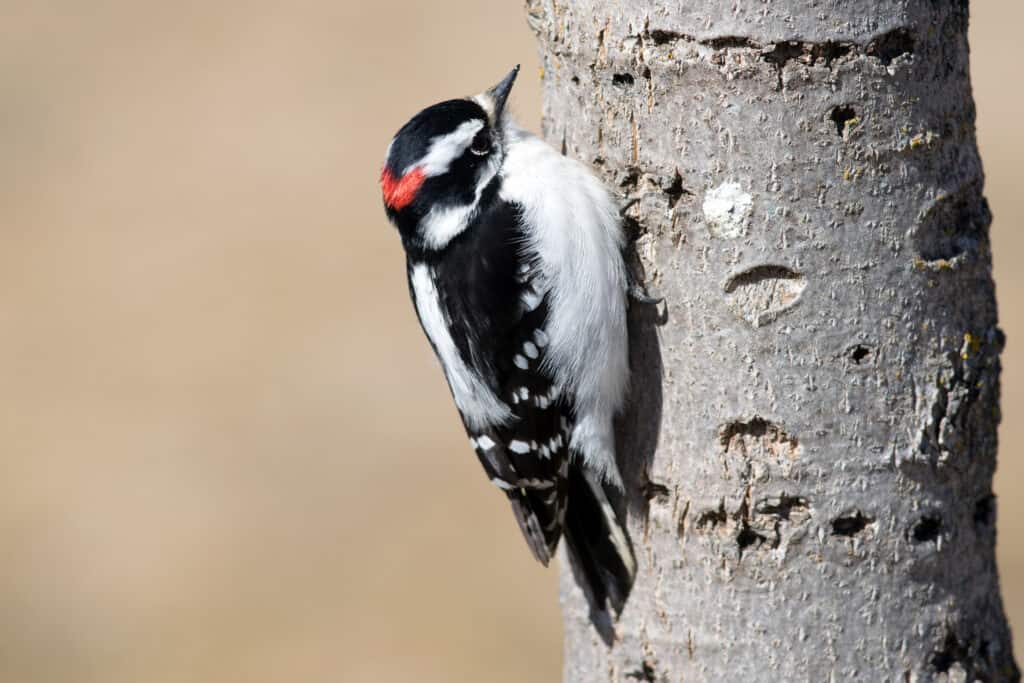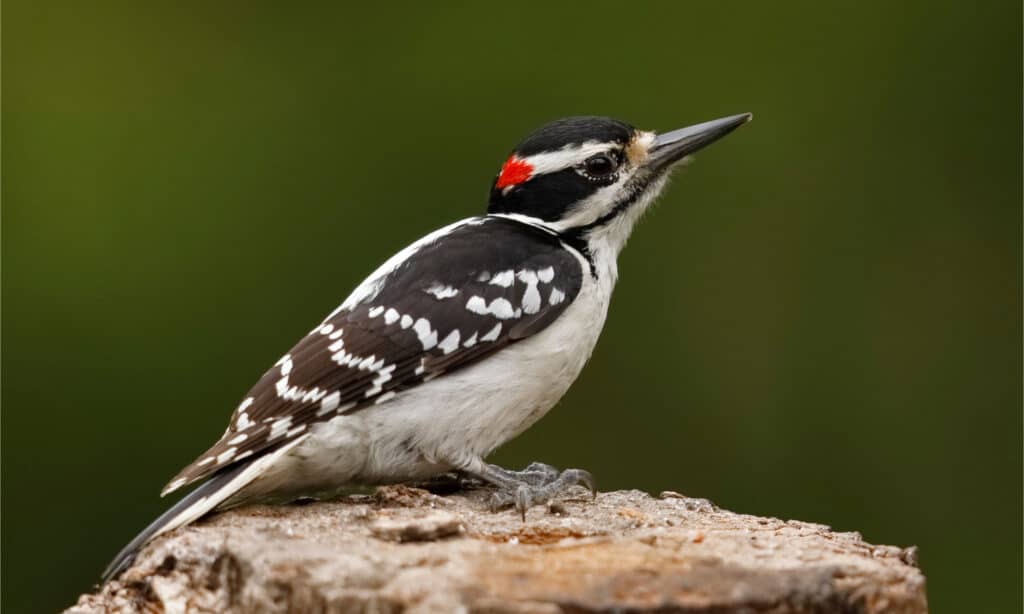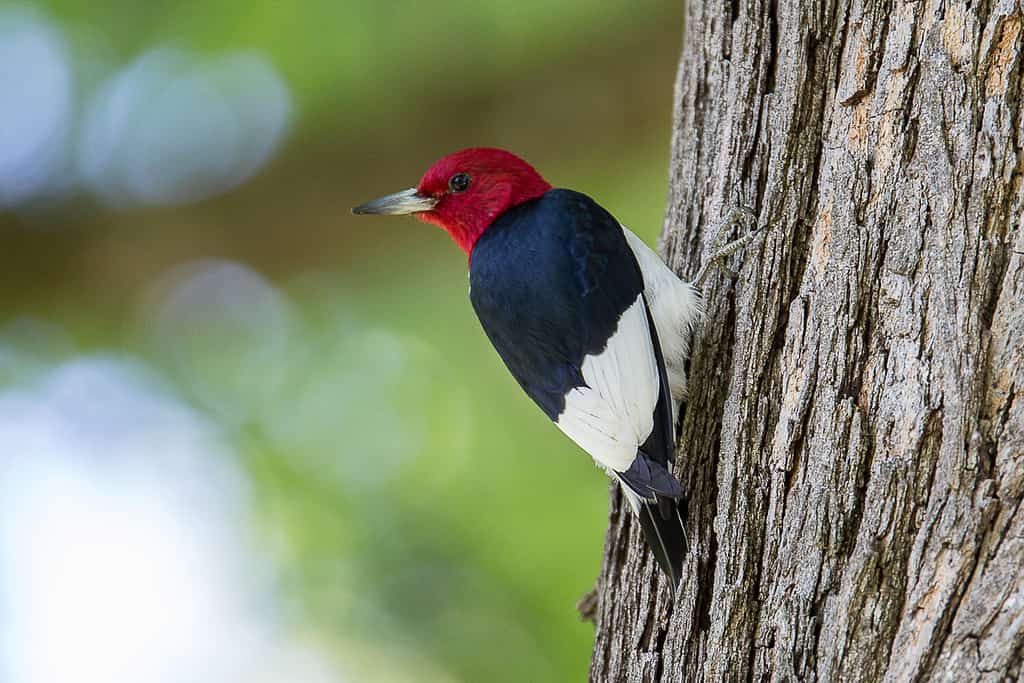North Carolina is home to a wide variety of bird species. In fact, there are more than 475 different wild bird species that roam the skies of the Tar Heel State. Among these hundreds of birds, you will also find several different species of woodpeckers. For the most part, these species can be found in mature forests, although they may live elsewhere outside of the state. Keep reading below to meet the seven most common species of woodpeckers in North Carolina!
1. Downy Woodpecker
The downy woodpecker (Dryobates pubescens) is the smallest woodpecker species in North America. It is also one of the many species of woodpeckers in North Carolina. On average, an adult of this species will grow to lengths of 5.5 to 7.1 inches. Males have a small, bright red cap, whereas the markings on the female are completely black. Their chests are white, and their wings sport white spots. The black on the face comprises a mask, banding from their eye around their head. They are often confused with the hairy woodpecker. The two species look similar but are not closely related.

Downy woodpeckers are the smallest
woodpecker
species in North America.
©Northernguy/Shutterstock.com
2. Hairy Woodpecker
The hairy woodpecker (Leuconotopicus villosus) is similar in appearance to the downy woodpecker, as mentioned above. However, the banding on the face is much bolder, and the white markings on the wings are smaller. The bird itself is also larger, with adults of the species reaching an average length of around 9.8 inches.
There are seventeen subspecies of the hairy woodpecker. They are year-round residents that can be found throughout the majority of the state. They live in deciduous forests, where they eat insects as well as fruit.

Hairy woodpeckers are similar in appearance to the downy woodpecker.
©Brian Lasenby/Shutterstock.com
3. Northern Flicker
The northern flicker (Colaptes auratus) is also known as the common flicker. However, this is only one of over 100 common names for this species. Other names that you may know the northern flicker by include the gaffer woodpecker and gawker bird.
There are ten different subspecies, although one is extinct. The northern flicker you’ll most likely encounter in North Carolina is the southern yellow-shafted flicker (C. a. auratus). They have a red cap at the back of their head but yellow markings under the tail and primaries. Males of this species will have a black marking on their face near the beak that resembles a mustache.
This species is found year-round in North Carolina, although their availability may vary elsewhere in the continent.

4. Pileated Woodpecker
Pileated woodpeckers (Dryocopus pileatus) are a rather large woodpecker species with a distinct appearance.
The majority of the body of this bird is black. However, the face and neck are white with black markings. One black marking extends in either direction horizontally from the eye, like a mask. The other runs from the beak to the throat, which is also black. In males, this marking may be red around the beak before transitioning to black. Both males and females sport a bright red crest at the top of their heads.
You’re most likely to see pileated woodpeckers in North Carolina during the breeding season. They are most often found in mature forests.

This species has a bright red crest!
©Vlad G/Shutterstock.com
5. Red-Bellied Woodpecker
The red-bellied woodpecker (Melanerpes carolinus) is a common species in North Carolina. They are medium-sized birds that are mostly white. Their wings sport a distinct black banding, and they have a bright orange-red cap on their head. This extends down the nape of their neck as well. They are named for the reddish tint that colors their underbelly, although it is less noticeable than their cap.
They live in the eastern region of the United States all year. Occasionally, they can be found as far north as Canada. Within their range, they may migrate depending on the season and availability of resources.

Red-bellied woodpeckers are named for the slight red coloration on their chests and bellies.
©rck_953/Shutterstock.com
6. Red-Cockaded Woodpecker
Thus far, most of the woodpeckers in North Carolina have spotted bold red markings on their plumage. However, that is not the case for the more subtle red-cockaded woodpecker (Leuconotopicus Borealis).
This species is mostly black with a white belly. They also have white markings on their face, as well as white spots speckled across their wings. The latter is best seen during flight from above or when their wings are otherwise expanded. However, adult males of the species will also have a small, almost unnoticed red streak at the border of their cheek, for which they are named.
This woodpecker is endemic to the southeastern United States.

A red-cockaded woodpecker may not look like a typical woodpecker at first glance.
©feathercollector/Shutterstock.com
7. Red-Headed Woodpecker
The red-headed woodpecker (Melanerpes erythrocephalus) doesn’t display any of the intricate markings of other woodpeckers in North Carolina. Instead, their coloration is bold, with a black back, white chest, and solid red head. They are a near-threatened species found year-round throughout much of North America, with breeding and wintering habitats as well.

Red-headed woodpeckers have solid red heads with bold black and white markings on their bodies as well.
©Benjamin King/Shutterstock.com
The photo featured at the top of this post is © Jennifer Bosvert/Shutterstock.com
Thank you for reading! Have some feedback for us? Contact the AZ Animals editorial team.






